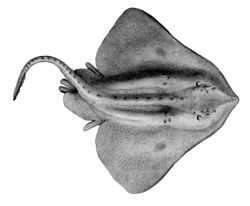| Skates Temporal range: [1] | |
|---|---|
 | |
| Arctic skate, Amblyraja hyperborea | |
| Scientific classification | |
| Kingdom: | Animalia |
| Phylum: | Chordata |
| Class: | Chondrichthyes |
| Subclass: | Elasmobranchii |
| Order: | Rajiformes |
| Family: | Rajidae Bonaparte, 1831 |
Skates are cartilaginous fish belonging to the family Rajidae in the superorder Batoidea of rays. More than 150 species have been described, in 17 genera. [2] Softnose skates and pygmy skates were previously treated as subfamilies of Rajidae (Arhynchobatinae and Gurgesiellinae), but are now considered as distinct families. [2] Alternatively, the name "skate" is used to refer to the entire order of Rajiformes (families Anacanthobatidae, Arhynchobatidae, Gurgesiellidae and Rajidae). [2]
Contents
- Taxonomy and systematics
- Evolution
- Classification
- Description
- General Batoidea characteristics
- Skate specific characteristics
- Distribution and habitats
- Behavior and ecology
- Reproduction
- Diet and feeding
- Skates versus stingrays
- Conservation
- See also
- References
- External links
Members of Rajidae are distinguished by a stiff snout and a rostrum that is not reduced. [3] [4]






